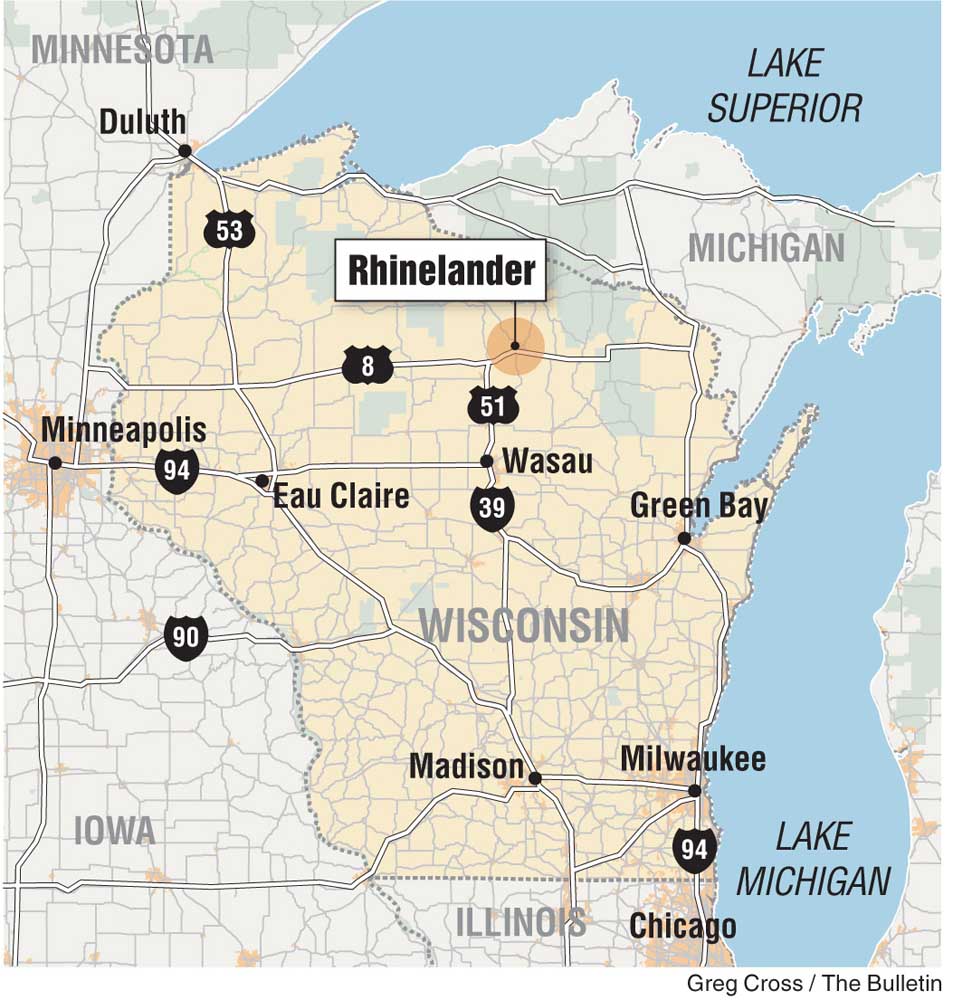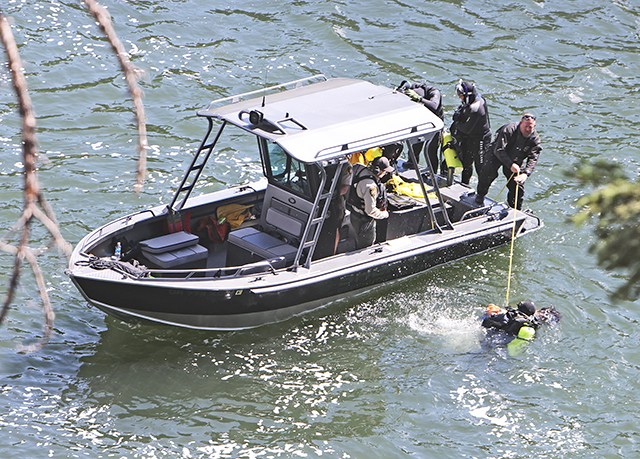A Father’s Day Tribute
Published 12:00 am Sunday, June 19, 2016

- A Father’s Day Tribute
ASHLAND, Wisconsin —
I’m not a churchgoer, but the words on the message board of Trinity Evangelical Lutheran Church in this northern Wisconsin town spoke to me.
Trending
I had heard them many times before, but never in the context of what I was now experiencing: “Praise Father Son and Holy Ghost,” they read.
That was, after all, why I was here, on the shores of Lake Superior, the great lake the native Ojibway people called Gitche Gumee.
I had come nearly 2,000 miles from my Oregon home, not on a Christian pilgrimage but rather to praise my flesh-and-blood father. I was returning to places of his youth and young adulthood, and of my own early childhood.
In doing so, I had also come to celebrate my son, who was never far from my mind. And I was here to honor the spirits of them both.
You see, this is likely the last year I will celebrate Father’s Day as either a son or a father. While Dad is many years in the grave, my own 32-year-old son, Erik, is rapidly losing his battle against liver cancer.
Ashland
Trending
I was born in Ashland, Wisconsin, on a chilly autumn evening in October 1950. That’s what my birth certificate says — everything but the “chilly.” Every fall night is chilly when north winds bluster in off Lake Superior.
I had no memories of Ashland. My father, a World War II veteran who earned a forestry degree on the GI Bill at nearby Michigan Technological College, was working as a quality control foreman at a chip mill, three blocks from the lake, when I made my appearance. Six months later, he took a better job in the larger city of Oshkosh, Wisconsin, and until June 1, fewer than three weeks ago, I had never returned to the town of my birth.
What I found at Ashland was a charming small town, a once-thriving lake port from which copper and iron ore and lumber were shipped across Superior and down the St. Lawrence Seaway to eastern ports. Today, its 8,000 residents (down from about 11,000 when I was born) make their livelihoods primarily from tourism, small manufacturing and Northland College, a 600-student school with a strong environmental science program.
Apart from the Apostle Islands National Lakeshore — most often visited by the Madeline Island ferry that departs from Bayfield, 23 miles north of Ashland — the town’s leading attraction is its murals. A pair of local artists have captured people, buildings and lifestyles from the 1890s to the 1950s on 17 colorful walls throughout the downtown area. Most are within easy walking distance of the Hotel Chequamegon, a beautiful lakefront lodge (now a member of the Best Western group) that opened in 1877.
I knew the name of the hospital where I was born: Trinity, the same as the church. The name didn’t appear in any phone listing. At the new city hospital, however, I found a woman who recalled its location and directed me to the historic structure. Four Corinthian columns distinguish the three-story, red-brick hospital building, since converted to senior apartments.
I had no information on my parents’ residence, but at the Northern Great Lakes Visitor Center, just west of town, I got the help I needed from the State Historical Society of Wisconsin. A city directory from 1950 directed me to a small home at the corner of Third Avenue West and Eighth Street. It’s still standing. And just around the corner is Trinity Lutheran, the church in which I probably was baptized.
Rhinelander
My father, Einar Anderson, had himself been born and raised two hours’ drive from Rhinelander, deep in Wisconsin’s North Woods. He was the youngest of five children of Swedish immigrants. His father and much older brother worked in the sawmills by day and fished for walleye and muskellunge in the nearby lakes during their hours off.
Dad graduated from Rhinelander High School in 1938 and spent the next few years working for an hourly wage as he puzzled over what he might do next. When the United States was hurried into war in late 1941, he enlisted in the service like many young men of his age. Taciturn and dependable, he rose to the rank of tech sergeant in the Army Air Corps, serving primarily at bases in England.
Returning Stateside in late 1945, he stopped by New York to meet a young woman with whom he had exchanged pen-pal letters for two years. Lilyan Gottberg’s parents were Scandinavian immigrants; she had been born and raised in Brooklyn and was a student at Columbia University. Two years later, they started their married life in Lake Superior country.
I had been to Rhinelander on a rare few previous occasions, most recently 30 years ago with Erik, then a toddler, and his mother. The Anderson clan had lived in the same house on Mason Street for more than a century, and only after Dad’s eldest sister passed away at age 99 was it sold. Her daughter and my cousin, Kathy Sutliff, continues to live in Rhinelander. And she was pleased to have someone in town with whom she could swap family stories.
One of our stops was the Forest Home Cemetery, where all of our grandparents are buried — the Sutliff forebears on her father’s side, my Gottberg ancestors and our mutual Anderson grandparents. John and Maja Gottberg are interred a few steps from the grave of Fred and Hilda Anderson. The last of them passed in 1964, more than 50 years ago.
I wanted to imagine how Dad lived his young life. A couple of old-time supper clubs, the Al-Gen and the restaurant at the Holiday Acres family resort, still served customers; in the evenings, I had breaded walleye at one, roasted duck with wild rice at the other. The beer was decidedly better than the wine, and Dad leaned toward Leinenkugel, made down the road in Chippewa Falls since 1867, although it’s now owned by Miller Brewing.
Unfortunately, the main downtown streets of Rhinelander, Davenport and Brown, were torn up for installation of a new utility system, and I could barely discern which buildings were the new ones and which the old. The Hext Theater was obviously a classic, but the Pied Piper, which Kathy said had been my father’s favorite watering hole, was now an insurance brokerage. The old Rhinelander High School had been replaced in 1959 by a new school, and all that remains is a mostly vacant park where there once was a football field.
Hodag country
Rhinelander loves its football, and the sturdy, working-class population would have loved that my son Erik played the game, even though he cheers for the Seattle Seahawks and not the Green Bay Packers. The Pack held their first training camps in the Rhinelander area in the 1920s. Renowned college coach John Heisman, whose name adorns the trophy given annually to the best player in college football, is buried in Forest Home near the Andersons and Gottbergs: His wife was a Rhinelander native.
Rhinelander celebrates its history at the Pioneer Park Historical Complex, an open-air logging museum with a train that once carried timber on the rail toward Milwaukee. It also has exhibits that tell of the feared Hodag.
Thank goodness for Hodags. The mythical animal of the North Woods provides a bridge from the Wisconsin of my father’s day to the Wisconsin I revisited. One Hodag has even traveled to Central Oregon as the mascot of the Hoodoo Ski Area.
Dad was a skier as far back as the 1930s. He and his buddies, guys like Bert Strong, who later met his wife skiing in Colorado, and Joe Schooley, a pilot who was shot down over North Africa during World War II, put together a local ski club called the Sitzmarkers. They installed a portable rope tow on a nearby hill and ran it on winter weekends.
Dad admitted that he never actually saw a Hodag. But he talked about the creature as if it were real. And Kathy said her Uncle Helmer, Dad’s older brother, counted his share of Hodag sightings after a weekend of deer hunting or, perhaps more frequently, a late night in a local tavern.
Rhinelander newcomers often get their first glimpse of a Hodag outside the visitor center on U.S. Highway 8, at the west end of this town of 7,700. It’s a fierce-looking creature, 7 feet long, part bear, part dinosaur, with white horns and claws like an oversized badger.
There’s also a Hodag standing vigil in front of the Oneida County Courthouse, with its dome of Tiffany glass. Another guards the entrance to the Rhinelander District Library, built in 1904 by the Carnegie Foundation. In fact, they are all over the little city in a variety of forms and colors, constructed on front lawns and sponsored by businesses. The waterfront on Boom Lake, on the Wisconsin River on the north side of town, is Hodag Beach. The Rhinelander High School sports teams, of course, are the Hodags, and they play at Hodag Field.
With the downtown streets blocked off, I was pleased to join a scavenger hunt devised by the Rhinelander Chamber of Commerce, encouraging visits to many of the town-center merchants — in search of Hodags, of course. From Mel’s Trading Post, a purveyor of outdoor goods, to banks and radio stations and the Rhinelander Cafe & Pub, I scoured shops to find Hodags of the molded, painted, carved and stuffed varieties. It provided a great opportunity to chat with local townspeople, all of whom showed the pride in their hometown that Dad always carried with him.
Marine on St. Croix
After the war, Dad returned to Rhinelander, got married, went to Tech, took a job in Ashland and moved to Oshkosh, where my younger brother was born. Two years later, he moved again, this time to the big city: A major corporation had a job for him in St. Paul, Minnesota, and a bright young man of his abilities surely could climb through middle management.
It’s hard to take a country boy and put him in the city, however. He settled his family 33 miles north of St. Paul in a delightful riverside hamlet called Marine on St. Croix. Even today, Marine’s population is less than 700. It was here, between the ages of 2½ and 5, that I had my earliest childhood memories.
As with Ashland, I hadn’t been back in six decades. But the moment I saw the general store, my memory was tickled. I remembered playing hide-and-seek with my mother on a shopping visit. I remembered blowing bubbles in my soft drink. I remembered telling a clerk, much to my mother’s embarrassment, that “My mommy was 29 yesterday but she’s 30 today!”
The store had the same neat aisles that it had six decades ago. The products were new, of course, and picture postcards had been replaced by souvenir “Marine Store” T-shirts, but I could still imagine myself as a 4-year-old shouting “Peek-a-boo!” from around a display rack.
Across the street and down a couple of hundred yards were a gas station and garage to which I had once “run away,” peddling my tricycle furiously down what is now a country lane. The garage owner, who had phoned my mother on the local party line and let her know I was safe with his grease monkeys and not in the river as she might have feared, was still alive at the age of 93, I was told.
I gleaned this information from an enigmatic Native American patron of the garage, a Chippewa man of about 50 who wouldn’t tell me his name — “I’m very careful about that,” he said — but asserted that he had lived here all his life. He recalled the names of families who had lived in the village even before he was born, and confirmed that I had correctly identified the house where my family had once lived.
It wasn’t as big as I had remembered. Everything is big to a 4-year-old. But it was charming, a shake-and-flagstone structure on a bluff above the St. Croix River, a Mississippi River tributary that is now protected as “wild and scenic” by the federal government.
When I was a little boy, my father warned me away from it unless I was in his company. “A boogeyman lives in that river, and if you go down there by yourself, he might drag you in,” Dad said with all the love a father could muster.
Dad’s company transferred him twice more, away from the Midwest, before we landed in Oregon in 1960. Instead of taking a position in sales management at the big-city corporate headquarters, he moved his young family (now with three kids) to the Willamette Valley, a region that had more in common with his beloved North Woods of Wisconsin.
Oregon has been home ever since. God bless my father.
Blessings
Erik was a big kid, strong and tough enough to play offensive line for his high school football team. He had a chance to keep playing at the small-college level, but he chose instead to remain in Seattle, studying internet technology while pursuing his passion for music, mainly as a performing disc jockey.
My only child, he was married in February to his high school sweetheart, Kim Chan. They both knew that Erik was sick. He had been diagnosed last October with hepatobiliary carcinoma. In the year prior, he had been losing weight faster than a “Biggest Loser” contestant. Doctors struggled to explain it until a scan finally revealed the cause.
I was in Rhinelander when Erik told me he was back in the hospital. He had been admitted for a procedure related to his cancer and there were complications. Now, in addition to the tumors in his liver and bile duct, his kidney function was going downhill fast.
“If you need me to get back, I can jump on a plane,” I told him. “No worries,” he replied. “I should be home in a couple of days.”
Throughout his ordeal, Erik’s peaceful demeanor has been almost uncanny. “Hey, we’re all going to die,” he told me recently. “I just know how I’m going to die.”
As my son approaches the transition from his too-short life, I want only that he should carry his pain no further than necessary. His stoic Scandinavian roots have given him no room for complaint, though this once-strapping young man is now a gaunt shadow of his former self.
Today, on Father’s Day 2016, I will be by Erik’s side at his Seattle home. He has left his information technology job and is now receiving hospice care.
God bless my son.
— Reporter: janderson@bendbulletin.com.
(Editor’s note: Erik Anderson succumbed to his cancer on June 20, 2016. One day after this story published.)








